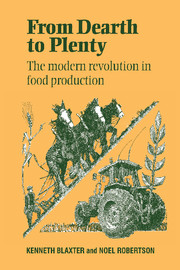Book contents
- Frontmatter
- Contents
- Preface
- Acknowledgements
- PART ONE The social, economic and political context of agricultural change
- PART TWO The science and technology of the modern agricultural revolution
- 3 Problems of measurement
- 4 Mechanisation
- 5 Soils, fertilisers and water
- 6 The control of weeds, pests and plant diseases
- 7 Breeding more productive plants
- 8 Integrations and innovations in crop husbandry
- 9 Hunger in the midst of plenty
- 10 Better and more productive animals
- 11 Animal health and disease
- 12 Integrations in animal husbandry
- PART THREE How did the science-based revolution happen, and what is the way forward as support is withdrawn?
- Glossary
- Index
6 - The control of weeds, pests and plant diseases
Published online by Cambridge University Press: 04 August 2010
- Frontmatter
- Contents
- Preface
- Acknowledgements
- PART ONE The social, economic and political context of agricultural change
- PART TWO The science and technology of the modern agricultural revolution
- 3 Problems of measurement
- 4 Mechanisation
- 5 Soils, fertilisers and water
- 6 The control of weeds, pests and plant diseases
- 7 Breeding more productive plants
- 8 Integrations and innovations in crop husbandry
- 9 Hunger in the midst of plenty
- 10 Better and more productive animals
- 11 Animal health and disease
- 12 Integrations in animal husbandry
- PART THREE How did the science-based revolution happen, and what is the way forward as support is withdrawn?
- Glossary
- Index
Summary
The human battle against organisms that destroy or compete with crops goes back to the beginning of farming history. In the past it has been mostly a losing battle. Today the enemy is largely contained; the techniques for control of weeds, pests and diseases of crops put into practice over the past fifty years have to a great extent determined the success of the latest agricultural revolution. Some of the substances used, derived from the success of synthetic organic chemistry, are highly effective but, wrongly used, may pose a threat to the natural environment; others depend on sophisticated biological understanding and need skill to be effective. In this chapter we hope to give a balanced view of the development of these powerful tools of husbandry and to evaluate their importance.
Weeds
Until 1940 control of weeds was largely by rotation, by cultivation and by the production of crop seed free from weed contamination. The whole arable cycle was determined more or less by the need to control weeds. Indeed a farmer's skill would be judged by the success of his weed control methods as shown by the appearance of his farm. There is no doubt that farmers successful in weed control were generally successful in financial terms, but there was no absolute relationship and it was possible to go bankrupt with a clean and well-cultivated farm when control of weeds took precedence over careful management of marketing and finance.
- Type
- Chapter
- Information
- From Dearth to PlentyThe Modern Revolution in Food Production, pp. 89 - 119Publisher: Cambridge University PressPrint publication year: 1995

